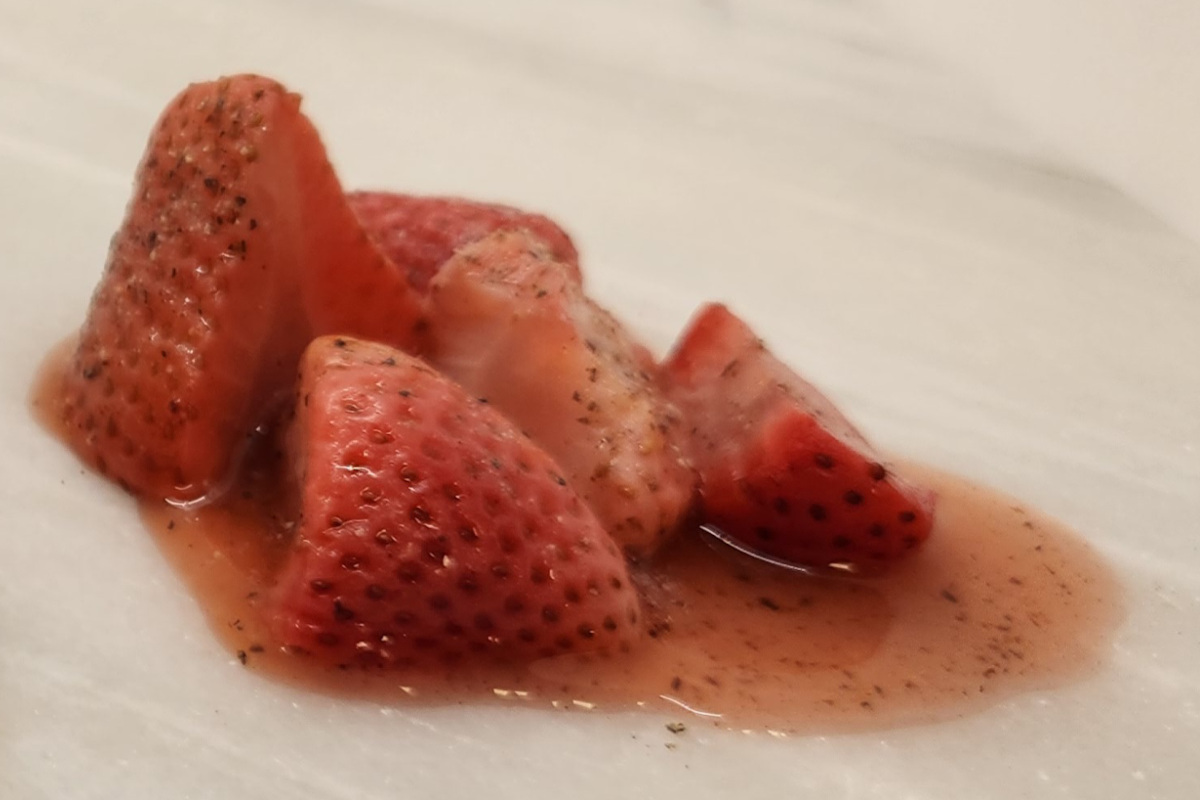Black Pepper Stewed Strawberries

Black Pepper Stewed Strawberries
Black pepper and strawberries might seem like an unlikely duo, but their flavors are surprisingly complementary. In this dish, the bold warmth of black pepper intensifies the strawberries' natural sweetness. The end result? A sweet, subtly spiced syrup that's just right for spooning over your favorite dessert. Yum!
Happy & Healthy Cooking,
Fun-Da-Mentals Kitchen Skills
- boil :
to cook a food in liquid heated to the point of gas bubbles and steam forming (boiling point is 212 F at sea level).
- chop :
to cut something into small, rough pieces using a blade.
- measure :
to calculate the specific amount of an ingredient required using a measuring tool (like measuring cups or spoons).
- simmer :
to cook a food gently, usually in a liquid, until softened.
Equipment Checklist
- Cutting board + kid-safe knife
- Small saucepan
- Dry measuring cups
- Measuring spoons
- Liquid measuring cup
- Wooden spoon
Ingredients
Black Pepper Stewed Strawberries
- 2 C fresh or frozen strawberries **(for STRAWBERRY ALLERGY sub blueberries)**
- 1 C water
- 1/2 C granulated sugar
- 1 tsp ground black pepper
Food Allergen Substitutions
Black Pepper Stewed Strawberries
- Strawberry: Substitute blueberries for strawberries.
Instructions
Black Pepper Stewed Strawberries
intro
Black pepper and strawberries may sound like a combination of flavors you never wanted to try but bear with me. In the 1980s, it became a trend to sprinkle black pepper on your strawberries before eating them. This strange flavor phenomenon took Europe by storm. The pairing combines the sweet and borderline sourness of strawberries with the subtle spice of black pepper to create a new and surprising flavor. This recipe is a saucy and sticky interpretation of that trendy flavor combo.
clean + chop
Rinse and remove the tops from 2 cups of strawberries, discarding the tops. Then, chop the strawberries into a large dice. Place all the chopped strawberries into a small saucepan.
measure + stir
Measure 1/2 cup sugar, 1 teaspoon black pepper, and 1 cup water and pour them into the pan with the chopped strawberries. Place the pan on your stove top and turn the heat to high. Stir until the sugar is dissolved.
boil + simmer
Once the mixture reaches a rolling boil, immediately turn the heat to medium-low and simmer for 10 minutes, or more. The longer you boil the mixture, the stickier and jam-like the berries will become.
cool + garnish
Allow the berries and syrup to cool for at least 5 minutes before using them. Drizzle the syrup over your favorite cake or ice cream. Scoop out some strawberries from the liquid and use those on top of our French Butter and Jam Cake. Bon appetit!

Hi! I'm Black Pepper!
"I started out as a fresh peppercorn, the fruit of a black pepper plant. Peppercorns are used as seasoning or spice in cooking. If peppercorns are dried, they may be put into a grinder and become ground black pepper. One of our favorite culinary partners is salt!"
History & Etymology
- Black pepper is native to South Asia and Southeast Asia, especially the Malabar Coast of India. It has been used in Indian cuisine for at least 4000 years. It was also used medicinally in ancient cultures.
- Black peppercorns were found in the nostrils of the Egyptian pharaoh Ramesses II (1279–1213 BCE).
- During India's Chera dynasty (300 BCE to 400 CE), black pepper was exported from the ancient port of Muziris and traded with Egypt, the Levant, Mesopotamia, the Roman Empire, and Yemen. At one time, peppercorns were called "black gold."
- Black pepper is one of the most popular spices around the world. Vietnam produces the most black pepper worldwide, followed by Brazil, Indonesia, and India.
- The word "pepper" is from the Middle English "peper," from the Old English "pipor," from the Latin "piper," from the Greek "peperi," and from Sanskrit "pippalī."
Anatomy
- The black pepper plant (Piper nigrum) is from the Piperaceae or pepper family of flowering plants. Its fruit, the peppercorn, is considered a stone fruit or drupe with a single seed inside.
- The plant is a perennial woody vine that grows up to 13 feet high. The vine may be supported by a nearby tree, post, or trellis. The mature fruit is red and about 1/4 inch in diameter.
- Piperine, an alkaloid or organic compound found in the black pepper plant's drupe and seed, is responsible for the pungent flavor of black pepper.
- Peppercorns can be black, green, red, pink, and white. Black pepper comes from the green, unripe drupe, which is cleaned and dried. When it is dry, the outer layer of the drupe becomes wrinkled and black, becoming a black peppercorn.
- Green pepper also comes from the green, unripe drupe but is treated in a way that keeps its green color.
- Red peppercorns are ripe drupes preserved in brine and vinegar. Like green peppercorns, they can be treated to keep their red color.
- White peppercorns are the seeds inside the fruit when the thin skin and flesh are removed. The ripe red fruit is soaked until the flesh dissolves, leaving the seed, which is then dried.
- Pink peppercorns are not from the Piper nigrum species. They are the fruit of the Peruvian pepper tree or the Brazilian pepper tree, which are from the Anacardiaceae or cashew family. Because of this, they can cause an allergic reaction similar to other tree nut allergies.
How to Store and Use
- Black pepper should be stored in an airtight container to preserve its taste and smell. Evaporation and light can affect its flavor, so food experts recommend using a pepper mill to grind whole dried peppercorns at the time of use.
- The fresh fruit is sometimes used in cooking without being dried. Fresh peppercorns are found in Thai cuisine and French cuisine, as in the French classic "steak au poivre" ("pepper steak").
- Ground white pepper is used in Chinese, Portuguese, and Thai dishes. It is often added to mashed potatoes instead of black pepper to blend in better with the white potatoes (no little black specks!).
- Ground black pepper is used as a general seasoning with salt in many foods, including cooked eggs, meats, and vegetables. It is added to marinades, rubs, salads, sauces, soups, spice blends, and stews.
- Freshly ground black pepper is essential to the Italian pasta dish "cacio e pepe" ("cheese and pepper").
- Peppercorn sauce is a cream sauce that combines any variety of whole peppercorns with heavy cream. Other typical ingredients include butter, garlic, salt, shallots, wine, brandy, and other seasonings. It may be served with beef, lamb, chicken, or fish dishes.
Nutrition
- Piperine, the alkaloid that gives black pepper its flavor, is also an antioxidant.
- One tablespoon of ground black pepper has 13 percent of the daily value (DV) of vitamin K and moderate amounts of iron (10 percent DV) and manganese (18 percent DV).
- Vitamin K is beneficial for building bone and blood clotting, helping wounds to heal. Manganese also aids bone health and wound healing and helps with carbohydrate metabolism.
What is Special About Strawberries with Black Pepper?

- Black pepper brings out the natural sweetness of strawberries, helps neutralize their acid, and enhances their flavor.
- A 15th-century cookbook described soaking strawberries in wine, straining them, and boiling them in a pot with almond milk and rice flour to thicken them. Then, add currants, saffron, pepper, sugar, ginger, vinegar, and lard before serving.
- In Italy in the 1980s, macerated strawberries with fresh ground black pepper became a popular way to eat the fruit.
- Strawberries with balsamic vinegar and black pepper have also recently become a trend.
Let's Learn About Italy!

- Italy became a unified country in 1861, only 150 years ago. It is sometimes called "bel paese" or "beautiful country."
- Italians invented the piano and the thermometer!
- In ancient Roman mythology, two twin brothers named Romulus and Remus founded Rome, Italy's capital city. The myth says the twins were abandoned and then discovered by a she-wolf before being found and raised by a shepherd and his wife. Eventually (and after many exciting adventures), they found themselves at the location of Palatine Hill, where Romulus built "Roma." The Italian wolf became Italy's unofficial national animal.
- In the 1930s and 40s, Mussolini, Italy's prime minister, and dictator tried to eliminate all foreign words from the Italian language. How did he do that? He just changed them! For example, in soccer, "goal" became "meta." Disney character names changed, too: Donald Duck became "Paperino;" Mickey Mouse became "Topolino;" and Goofy became "Pippo." Although they're not banned anymore, these words and names have stuck. So now if you go to the Italian Disneyland, called Gardaland Park, you will see Topolino and Pippo!
- About 60 million people call Italy home, and it is 116,350 square miles, slightly larger than the US state of Arizona. If you compare that to the United Kingdom, 67 million people live there, and it is about 94,350 square miles. So, the UK is smaller than Italy but has a bigger population!
- The Italian flag is green, white, and red. These colors represent hope, faith, and charity.
- The average Italian eats close to 55 pounds of pasta annually. If you think about how light pasta is, that is a considerable amount! There are more than 500 different types of pasta eaten in Italy today.
What's It Like to Be a Kid in Italy?
- Kids begin school at 6 years old. They grow up speaking Italian, but they learn English in school, so many become bilingual in Italian and English.
- The most popular sport for kids is football (soccer). The Italian word for soccer is "calcio," the same word they use for "kick." A favorite of younger kids is "Rody, the bouncing horse," a plastic horse that a small child can hop onto and bounce around the room. Rody was invented in Italy in 1984.
- The family ("la famiglia") is a central characteristic of Italian life. Children have great respect for their older relatives. It is traditional to name the first male child after the grandfather and the first female child after the grandmother.
- If kids live close to school, they can go home and have lunch with their families! Lunch at school might be pasta, meat with vegetables, a sandwich, or a salad with lots of ingredients. Families typically eat dinner later (7 to 8 pm), so kids end up staying up later, too!
- Between lunch and dinner, kids often enjoy "merenda," which is an afternoon snack that translates to "something that is deserved." It is really a mini-meal that can include both savory and sweet foods. Examples of savory foods are a salami or mortadella sandwich, a slice of rustic bread rubbed with a cut, raw tomato, or "pizza bianca" (white pizza without tomato sauce). Types of sweet foods eaten during merenda are "gelato" (a lower-fat type of ice cream), any kind of cake, or biscotti dipped in warm milk.




